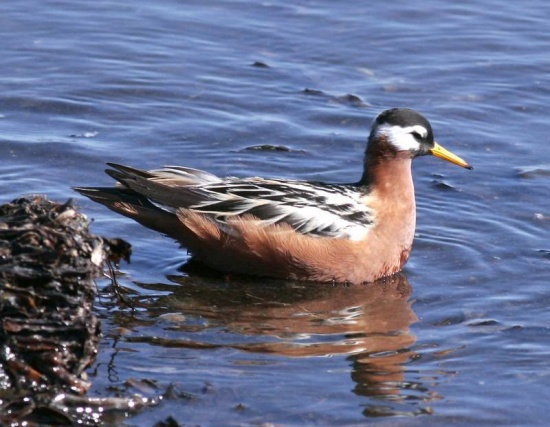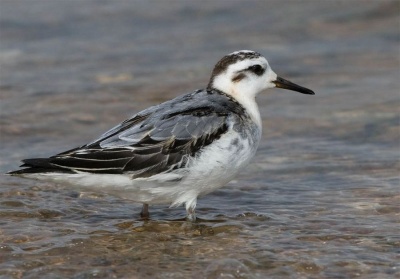- Phalaropus fulicarius
Alternative name(s): Grey Phalarope
Identification
L 20-22 cm, WS 36-41 cm. In Europe they are mostly seen in winter plumage when they are pale grey, with white underparts, a dark bill and thick black line through the eye. The lack of stripes on the back and the shorter, thicker bill distinguish them from Red-necked Phalaropes.
In summer, the adults are almost entirely red on their underparts (not just around the neck) and have a black and white head pattern and a mostly yellow bill; female has darker red and less black on the bill than the male. Adult and immature in winter are mostly grey with black bill.
The juveniles have streaks on the mantle like Red-necked Phalaropes but these soon disappear as they moult into first-winter plumage.
Distribution
Breeds in the Arctic and winters in the Atlantic off south and West Africa, travelling via migration routes well out in the north Atlantic. In western Europe, very rare in late spring; more regular September and October (especially on the west coast of Britain and Ireland), when gales bring singles or small groups (at times large numbers) close inshore, or odd birds to coastal pools.
Taxonomy
This is a monotypic species[1].
Habitat
Breeds in coastal wet tundra, sometimes in drier area, but always near fresh or brackish water. Most often quite pelagic in migration and winter.
Behaviour
Nest in tussock near shallow water. Typically seen swimming, often spinning rapidly or picking insects off water.
References
- Clements, JF. 2010. The Clements Checklist of Birds of the World. 6th ed., with updates to December 2010. Ithaca: Cornell Univ. Press. ISBN 978-0801445019. Spreadsheet available at http://www.birds.cornell.edu/clementschecklist/Clements%206.5.xls/view
Recommended Citation
- BirdForum Opus contributors. (2024) Red Phalarope. In: BirdForum, the forum for wild birds and birding. Retrieved 27 July 2024 from https://www.birdforum.net/opus/Red_Phalarope
External Links
GSearch checked for 2020 platform.1





